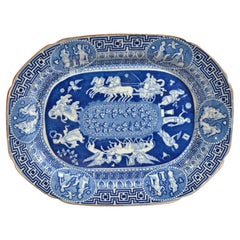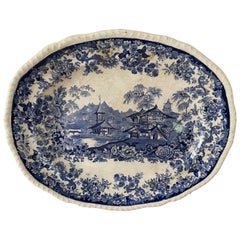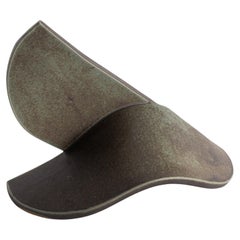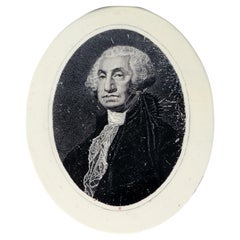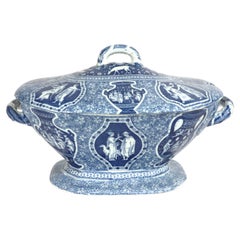Herculaneum Pottery
Herculaneum Pottery was started in Liverpool, England, in 1793. The factory made creamware and pearl-glazed creamware pottery as well as bone china porcelain. The National Museums Liverpool has an excellent collection of Herculaneum ceramics.
to
2
2
1
1
2
2
2
2
2
2
2
2
2
2
2
5
72
49
49
34
Creator: Herculaneum Pottery
Regency Herculaneum Greek Pattern Blue Printed Pottery Dish
By Herculaneum Pottery
Located in Downingtown, PA
Herculaneum Neo-classical large Greek pattern blue printed dish,
Early-19th century
The Herculaneum pottery underglaze blue central pattern shows ase...
Category
Early 19th Century English George III Antique Herculaneum Pottery
Materials
Pearlware, Pottery
Regency Herculaneum Neo-Classical Greek Pattern Blue Printed Dish
By Herculaneum Pottery
Located in Downingtown, PA
Herculaneum neo-Classical Greek Pattern blue printed dish,
Early-19th century
The Herculaneum pottery underglaze blue central pattern shows a s...
Category
Early 19th Century English Neoclassical Antique Herculaneum Pottery
Materials
Pearlware, Pottery
Related Items
1874 Minton Chinese Blue and White Transferware Platter
By Minton
Located in Sheffield, MA
An antique 19th century Minton Chinese blue and white transferware platter. It has a lovely pastoral scene. The underside is marke...
Category
19th Century English Chinoiserie Antique Herculaneum Pottery
Materials
Pottery
$300 Sale Price
33% Off
H 1.38 in W 13.25 in D 10.58 in
Torin Sculpture by Charlie Dumais
By Dumais Made
Located in Bantam, CT
Our stoneware Torin Sculpture is handcrafted using slab-construction techniques.
FINISH
- Dipped glaze, pictured in verdigris
DIMENSIONS
Base: 13.5” x 9"
Height: 16”
Made to or...
Category
2010s American Herculaneum Pottery
Materials
Ceramic, Clay, Pottery, Stoneware
Stack Bowl by Charlie Dumais
By Dumais Made
Located in Bantam, CT
Our stoneware Stack Bowl is handcrafted using slab-construction techniques.
FINISH
- Dipped ochre glaze
DIMENSIONS
16.5" Dia x 4.5" H
Made to order ...
Category
2010s American Herculaneum Pottery
Materials
Ceramic, Clay, Pottery, Stoneware
Glazed Ceramic Charger Stamped Germany 289-29
Located in Chicago, IL
West German ceramic wall plate or charger. Crisp glaze and Greek key center pattern with caramel and blue glaze alternating circles. Nice lava relief to the Greek key detail.
Category
20th Century German Herculaneum Pottery
Antique French Asparagus Plate by Emile Galle c1880's
By Émile Gallé
Located in Chicago, IL
Antique Earthenware asparagus plate, made by Emile Galle, French, about 1883
signed Emile Galle, Nancy, Depose.
Category
19th Century French Antique Herculaneum Pottery
Materials
Earthenware
Ro Ro Handmade Studio Pottery Blue Glazed Dish, 1960s
By Gordon & Jane Martz
Located in Miami, FL
Mid Century Studio Pottery dish or serving plate rendered in hand thrown clay with a pale blue glazed interior, by Ro Ro, 1960s. Stamped on bottom.
Category
Mid-20th Century American Mid-Century Modern Herculaneum Pottery
Materials
Clay
Villeroy & Boch Art Nouveau Tubelined Floral Majolica Pottery Tazza
By Villeroy & Boch
Located in Bishop's Stortford, Hertfordshire
A very stylish Villeroy & Boch Art Nouveau Majolica pottery tazza or cake stand decorated with tubelined floral designs dating circa 1900. The tazza stands on a bell shaped foot and ...
Category
Early 1900s German Art Nouveau Antique Herculaneum Pottery
Materials
Majolica
Fine Antique Meissen Porcelain Blue Onion Pattern 2 Lobed Serving Dish
By Meissen Porcelain
Located in Tustin, CA
Very fine, elegant antique handmade and hand painted Meissen porcelain, 2 lobed scalloped serving dish with rocaille handle in the "Blue Onion" pattern. In perfect condition.
The ...
Category
Early 20th Century German Rococo Herculaneum Pottery
Materials
Porcelain
$975
H 4.75 in W 11.5 in D 1.75 in
Minton Majolica Game Pie Tureen, Rabbit, Mallard and Dove, Victorian 1881
By Minton
Located in London, GB
This is a stunning game pie tureen with cover made by Minton in 1881. The piece is made of majolica and has realistically relief-moulded game on the cover: a rabbit, a mallard and a ...
Category
1880s English Victorian Antique Herculaneum Pottery
Materials
Majolica
$3,075 / set
H 7.25 in W 13.75 in D 8.75 in
Early Spode Red Greek Pattern Tile
By Spode, Josiah Spode
Located in Fort Lauderdale, FL
A Neoclassical red transferware tile made by Spode 1806-1810, with the ‘Refreshments for Phliasian Horseman’ pattern.
Sir William Hamilton’s Collection of Etruscan, Greek and Roman antiquities, first published in 1766 by Pierre d’Hancarville, was a landmark publication in English design. It intended to disseminate the Antique style through its engravings of Attic pottery. The catalog’s faithful reproductions of Classical vases led British potteries, including Spode, to adapt or even copy the ancient art for modern life. These Spode Greek pattern tiles reflect the major influence of Hamilton’s catalog on English Neoclassicism. The central scene was taken directly from the catalog.
This tile can be dated to a narrow window of production in the Spode factory, 1806-1810. During that time, Spode used a technique known as the “Pluck and Dust” method to print in red transfer designs onto creamware. Using this method, source prints were transferred overglaze using tissue imprinted with a very faint rendition of the design outlined in sticky oil. The decorator applied the tissue to the object then carefully “plucked” or pulled it away, leaving the sticky oil design behind. Then, a finely-ground enamel color was “dusted” onto the surface, sticking to any areas that had the oil. A final firing at a low temperature in the enamel kiln made the pattern permanent. The Pluck and Dust technique improved upon bat-printing and enabled larger designers to be transferred. It was short-lived, however, as under-glaze transfer printing soon took over as the preferred method for producing transferwares.
Dimensions: 5 in. x 5 in. x 1/4 in.
Condition: Excellent. Slight chip to the upper left corner measuring approximately 0.9 cm. in length.
Provenance:
The Collection of Nancy and Andrew Ramage
Jonathan Horne...
Category
Early 19th Century English Neoclassical Antique Herculaneum Pottery
Materials
Earthenware, Creamware
Early 19th Century Spode Red Greek Pattern Tile
By Spode, Josiah Spode
Located in Fort Lauderdale, FL
A Neoclassical red transferware tile made by Spode 1806-1810, with the ‘Zeus in His Chariot’ pattern.
Sir William Hamilton’s Collection of Etruscan, Greek and Roman antiquities, first published in 1766 by Pierre d’Hancarville, was a landmark publication in English design. It intended to disseminate the Antique style through its engravings of Attic pottery. The catalog’s faithful reproductions of Classical vases led British potteries, including Spode, to adapt or even copy the ancient art for modern life. These Spode Greek pattern tiles reflect the major influence of Hamilton’s catalog on English Neoclassicism. The central scene was taken directly from the catalog.
This tile can be dated to a narrow window of production in the Spode factory, 1806-1810. During that time, Spode used a technique known as the “Pluck and Dust” method to print in red transfer designs onto creamware. Using this method, source prints were transferred overglaze using tissue imprinted with a very faint rendition of the design outlined in sticky oil. The decorator applied the tissue to the object then carefully “plucked” or pulled it away, leaving the sticky oil design behind. Then, a finely-ground enamel color was “dusted” onto the surface, sticking to any areas that had the oil. A final firing at a low temperature in the enamel kiln made the pattern permanent. The Pluck and Dust technique improved upon bat-printing and enabled larger designers to be transferred. It was short-lived, however, as under-glaze transfer printing soon took over as the preferred method for producing transferwares.
Dimensions: 5 in. x 5 in. x 1/4 in.
Condition: Excellent.
Provenance:
The Collection of Nancy and Andrew Ramage
Jonathan Horne...
Category
Early 19th Century English Neoclassical Antique Herculaneum Pottery
Materials
Earthenware, Creamware
French Provincial 1850s Green Glazed Hors d'Œuvres Dish with Scalloped Edges
Located in Atlanta, GA
A French Provincial green glazed pottery Hors d'Œuvres dish from the mid 19th century, with scalloped edges and orange accents. Created in Provence during the reign of Emperor Napolé...
Category
Mid-19th Century French French Provincial Antique Herculaneum Pottery
Materials
Pottery
Previously Available Items
Liverpool Creamware Desk Plaque of George Washington
By Herculaneum Pottery
Located in Downingtown, PA
Liverpool Creamware Plaque of George Washington,
Herculaneum Pottery,
Circa 1800
The Liverpool creamware plaque depicts the Gilbert Stuart ima...
Category
Late 18th Century English Federal Antique Herculaneum Pottery
Materials
Creamware, Pottery
Antique Herculaneum Pottery Neo-Classical Greek Pattern Blue Soup Tureen & Cover
By Herculaneum Pottery
Located in Downingtown, PA
Herculaneum Pottery neo-classical Greek pattern blue soup tureen & cover
Early-19th century
The Herculaneum Greek pattern pottery soup tureen and...
Category
Early 19th Century English Neoclassical Antique Herculaneum Pottery
Materials
Pearlware, Pottery
H 8.75 in W 13.75 in D 8 in
Rare 19th Century Herculaneum Factory ‘Greek Pattern’ Cabinet Plate, Circa 1805
By Herculaneum Pottery
Located in Ottawa, Ontario
This rare Herculaneum factory cabinet plate showing classical theme transfer decoration against a terracotta vermiculé ground, the underside bearing the impressed letter H denoting Herculaneum Potteries, Liverpool.
Herculaneum Potteries produced wares for a relatively brief period of time, from 1793-1841.
A very rare and attractive study piece...
Category
Early 19th Century English Greek Revival Antique Herculaneum Pottery
Materials
Earthenware
Red Antique Greek Ware Dishes Eight in a Neoclassical Pattern in Stock
By Herculaneum Pottery
Located in Katonah, NY
A set of eight red antique Greek ware dinner dishes in a vibrant neoclassical pattern made by the Herculaneum factory, circa 1810.
Within the group of eight dishes six of the dishes...
Category
Early 19th Century English Neoclassical Antique Herculaneum Pottery
Materials
Earthenware
Rare Pair of 19th Century Herculaneum Pottery Plates, Liverpool, circa 1805
By Herculaneum Pottery
Located in Ottawa, Ontario
A rare pair of early 19th century Herculaneum pottery cabinet plates decorated in the 'Greek Pattern'. Both plates showing black and white transfer...
Category
Early 19th Century English George III Antique Herculaneum Pottery
Materials
Pottery
Herculaneum Pottery pottery for sale on 1stDibs.
Herculaneum Pottery pottery are available for sale on 1stDibs. These distinctive items are frequently made of earthenware and are designed with extraordinary care. There are many options to choose from in our collection of Herculaneum Pottery pottery, although blue editions of this piece are particularly popular. Many of the original pottery by Herculaneum Pottery were created in the neoclassical style in united kingdom during the 19th century. If you’re looking for additional options, many customers also consider pottery by Hicks & Meigh, Josiah Spode, and Spode. Prices for Herculaneum Pottery pottery can differ depending upon size, time period and other attributes — on 1stDibs, these items begin at $475 and can go as high as $3,000, while a piece like these, on average, fetch $1,950.

